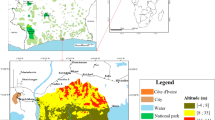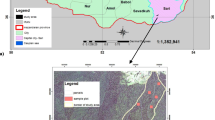Abstract
The determination of segments that represents an optimal image object size is very challenging in object-based image analysis (OBIA). This research employs local variance and spatial autocorrelation to estimate the optimal size of image objects for segmenting forest stands. Segmented images are visually compared to a manually interpreted forest stand database to examine the quality of forest stand segmentation in terms of the average size and number of image objects. Average local variances are then graphed against segmentation scale in an attempt to determine the appropriate scale for optimally derived segments. In addition, an analysis of spatial autocorrelation is performed to investigate how between-object correlation changes with segmentation scale in terms of over-, optimal, and under-segmentation.
Access this chapter
Tax calculation will be finalised at checkout
Purchases are for personal use only
Preview
Unable to display preview. Download preview PDF.
Similar content being viewed by others
References
Benz, UC, Hofmann P, Willhauck G, Lingenfelder I, Heynen M (2004) Multi-resolution, object-oriented fuzzy analysis of remote sensing data for GIS-ready information. ISPRS Journal of Photogrammetry and Remote Sensing 58:239-258
Blaschke T (2003) Object-based contextual image classification built on image segmentation. Advances in Techniques for Analysis of Remotely Sensed Data 2003 IEEE Workshop:113-119
Blaschke T, Strobl J (2001) What’s wrong with pixels? Some recent developments interfacing remote sensing and GIS. GIS-Zeitschrift für Geoinformationssysteme 6:12-17
Brandtberg T, Warner T (2006) High resolution remote sensing. In: G. Shao and K. M. Reynolds (eds) Computer Applications in Sustainable Forest Managment, Springer Verlag, Dordrecht, Netherlands, pp 19-41
Cao C, Lam NS (1997) Understanding the scale and resolution effects in remote sensing and GIS. In: D.A. Quattrochi and M.F. Goodchild (eds) Scale in Remote Sensing and GIS, CRC Press Inc., U.S., pp 57-72
Definiens (2004) eCognition User Guide 4, Definiens AG, Germany
Dorren LKA, Maier B, Seijmonsbergen AC (2003) Improved Landsat-based forest mapping in steep mountainous areas using object-based classification. Forest Ecology and Management 183:31-46
Ehlers M, Gähler M, Janowsky R (2003) Automated analysis of ultra high resolution remote sensing data for biotope type mapping: new possibilities and challenges. ISPRS Journal of Photogrammetry and Remote Sensing. 57:315-326
Fisher P (1997) The pixel: a snare and a delusion. International Journal of Remote Sensing 18(3):679-685
Grossman DH, Faber-Langendoen D, Weakley AS, Anderson M, Bourgeron P, Crawford R, Goodin K, Landaal S, Metzler K, Patterson KD, Payne M, Reid M, Sneddon L (1998) International Classification of Ecological Communities: Terrestrial Vegetation of the United States. vol I. The National Vegetation Classification System: Development, Status and Applications. The Nature Conservancy, Arlington, Virginia, p 126
Hiatt J (2003) Guilford Courthouse National Military Park: Cultural Landscape Report. National Park Service, Southeast Regional Office, Cultural Resources Division, http://www.nps.gov/guco/pphtml/documents.html, Accessed last on March 22, 2006
Kim M, Madden M (2006) Determination of optimal scale parameter for alliance-level forest classification of multispectral IKONOS image. Commission IV, WG IV/4 on Proceeding of 1st OBIA Conference, Salzburg, Austria
Madden M, Welch R, Jordan T, Jackson P, Seavey R and Seavey J (2004) Digital Vegetation Maps for the Great Smoky Mountains National Park, Final Report to the U.S. Dept. of Interior, National Park Service, Cooperative Agreement Number 1443-CA-5460-98-019, Center for Remote Sensing and Mapping Science, The University of Georgia, Athens, Georgia, p 112
Meinel G, Neubert M (2004) A comparison of segmentation programs for high resolution remote sensing data. Commission VI on Proceeding of 20th ISPRS Congress in Istanbul, www.isprs.org/istanbul2004/comm4/papers/506.pdf, Accessed on October 16, 2005
NatureServe (2007) Accuracy Assessment: Guilford Courthouse National Military Park, Final Report to the National Park Service, Durham, North Carolina
Shiewe J, Tufte L, Ehlers E (2001) Potential and problems of multi-scale segmentation methods in remote sensing. GIS-Zeitschrift für Geoinformationssysteme 6:34-39
Townshend JRG, Huang C, Kalluri SNV, Defries RS, Liang S, Yang K (2000) Beware of per-pixel characterization of land cover. International Journal of Remote Sensing 21(4):839-843
Warner T (1999) Analysis of spatial pattern in remotely sensed data using multivariate spatial autocorrelation. Geocarto International 14(1):59-65
Warner T, Shank M (1997) Spatial autocorrelation analysis of hyperspectral imagery for feature selection. Remote Sensing of Environment 60:58-70
Warner T, Steinmaus K, Foote H (1999) An evaluation of spatial autocorrelation-based feature selection. International Journal of Remote Sensing 20(8):1601-1616
Welch R, Madden M, Jordan T (2002) Photogrammetric and GIS techniques for the development of vegetation databases of mountainous areas: Great Smoky Mountains National Park. ISPRS Journal of Photogrammetry and Remote Sensing 57(1-2): 53-68
Woodcock CE, Strahler AH (1987) The factor of scale in remote sensing. Remote Sensing of Environment 21:311-332
Yu QP, Gong N, Clinton G, Biging MK, Shirokauer D (2006) Object-based detailed vegetation classification with airborne high spatial resolution remote sensing imagery. Photogrammetic Engineering and Remote Sensing 72(7):799-811
Author information
Authors and Affiliations
Editor information
Editors and Affiliations
Rights and permissions
Copyright information
© 2008 Springer-Verlag Berlin Heidelberg
About this chapter
Cite this chapter
Kim, M., Madden, M., Warner, T. (2008). Estimation of optimal image object size for the segmentation of forest stands with multispectral IKONOS imagery. In: Blaschke, T., Lang, S., Hay, G.J. (eds) Object-Based Image Analysis. Lecture Notes in Geoinformation and Cartography. Springer, Berlin, Heidelberg. https://doi.org/10.1007/978-3-540-77058-9_16
Download citation
DOI: https://doi.org/10.1007/978-3-540-77058-9_16
Publisher Name: Springer, Berlin, Heidelberg
Print ISBN: 978-3-540-77057-2
Online ISBN: 978-3-540-77058-9
eBook Packages: Earth and Environmental ScienceEarth and Environmental Science (R0)




